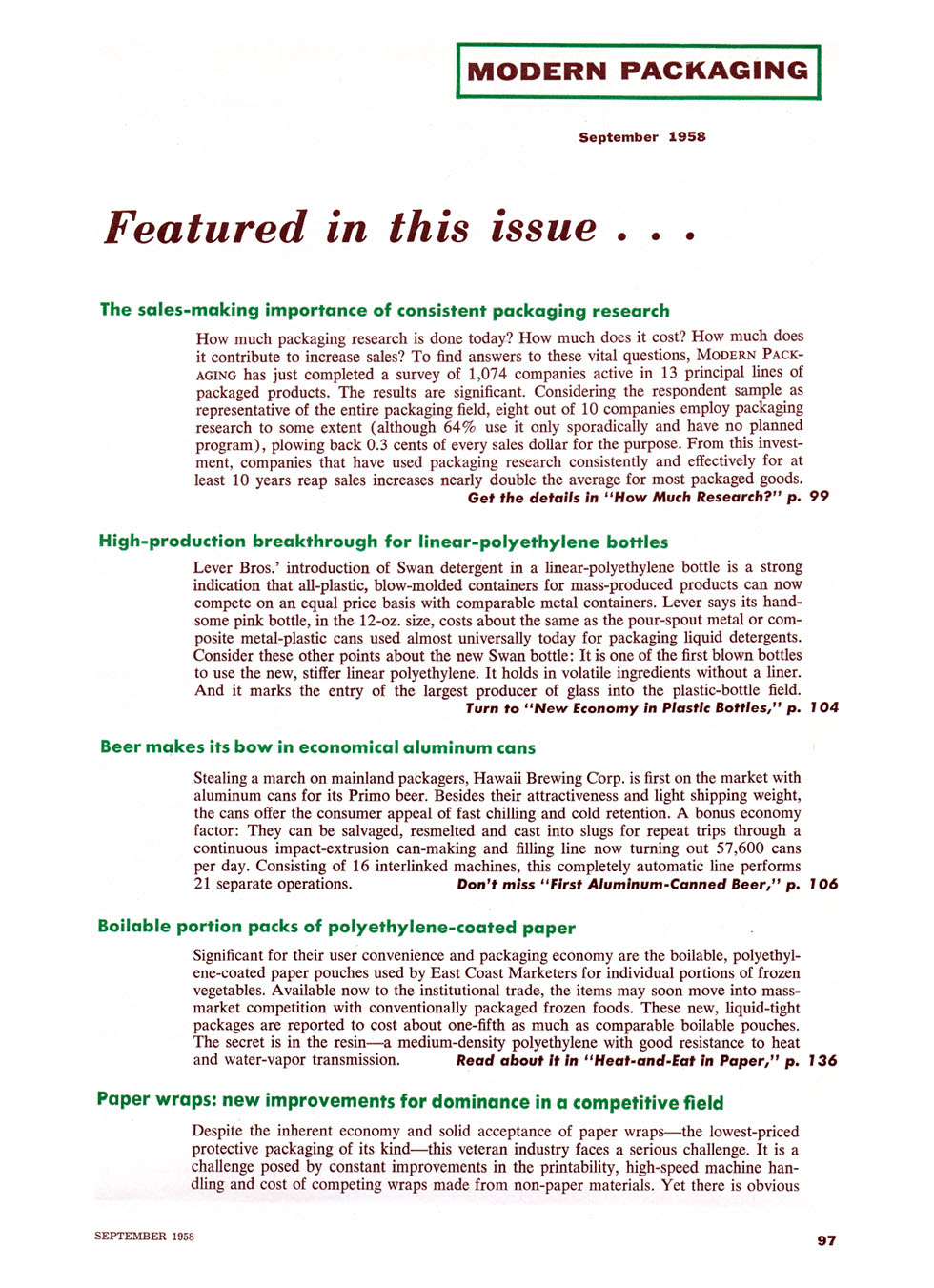


MODERN PACKAGING
September 1958
Featured in this issue . . .
The soles-mcikiticj Importance of consistent packaging research
How much packaging research is done today? How much does it cost? How much does it contribute to increase sales? To find answers to these vital questions, Modern Packaging has just completed a survey of 1,074 companies active in 13 principal lines of packaged products. The results are significant. Considering the respondent sample as representative of the entire packaging field, eight out of 10 companies employ packaging research to some extent (although 64% use it only sporadically and have no planned program), plowing back 0.3 cents of every sales dollar for the purpose. From this investment, companies that have used packaging research consistently and effectively for at least 10 years reap sales increases nearly double the average for most packaged goods.
Get the details in 6"˜How Much Research?â„¢ p. 99
High-production breakthrough for linear-polyethylene bottles
Lever Bros.5 introduction of Swan detergent in a linear-polyethylene bottle is a strong indication that all-plastic, blow-molded containers for mass-produced products can now compete on an equal price basis with comparable metal containers. Lever says its handsome pink bottle, in the 12-oz. size, costs about the same as the pour-spout metal or composite metal-plastic cans used almost universally today for packaging liquid detergents. Consider these other points about the new Swan bottle: It is one of the first blown bottles to use the new, stiffer linear polyethylene. It holds in volatile ingredients without a liner.
And it marks the entry of the largest producer of glass into the plastic-bottle field.
Turn to "New Economy in Plastic Bottles,â„¢ p. 104
Beer makes its bow In economical aluminum cans
Stealing a march on mainland packagers, Hawaii Brewing Corp. is first on the market with aluminum cans for its Primo beer. Besides their attractiveness and light shipping weight, the cans offer the consumer appeal of fast chilling and cold retention. A bonus economy factor: They can be salvaged, resmelted and cast into slugs for repeat trips through a continuous impact-extrusion can-making and filling line now turning out 57,600 cans per day. Consisting of 16 interlinked machines, this completely automatic line performs 21 separate operations. Don't miss "First Aluminum-Canned Beer,â„¢ p. 106
Bailable portion packs of polyethylene-coated paper
Significant for their user convenience and packaging economy are the boilable, polyethylene-coated paper pouches used by East Coast Marketers for individual portions of frozen vegetables. Available now to the institutional trade, the items may soon move into mass-market competition with conventionally packaged frozen foods. These new, liquid-tight packages are reported to cost about one-fifth as much as comparable boilable pouches.
The secret is in the resin a medium-density polyethylene with good resistance to heat and water-vapor transmission. Read about it in "Heat-and-Eat in Paper,â„¢ p. 136
Paper wraps: new improvements for dominance in a competitive field
Despite the inherent economy and solid acceptance of paper wrap-”the lowest-priced protective packaging of its kind this veteran industry faces a serious challenge. It is a challenge posed by constant improvements in the printability, high-speed machine handling and cost of competing wraps made from non-paper materials. Yet there is obvious